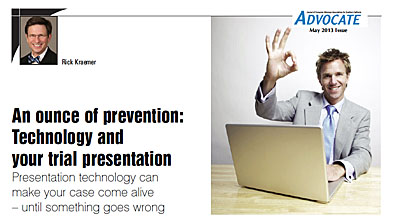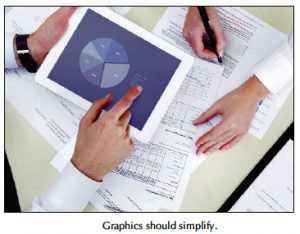
Third In A Series: An Ounce Of Prevention — Trial
August 15, 2013
Last In A Series: An Ounce Of Prevention — Graphics
August 22, 2013Previously: Part 1 | Part 2 | Part 3
 With the Consumer Attorney’s Association of Los Angeles’ (CAALA) annual Las Vegas Convention arriving August 29, we’re serializing a feature article on trial presentation that appeared in the May 2013 issue of CAALA’s Advocate Magazine. Last week, Rick looked at the technology and tactics that will put less error in your trial. This week he explores the power of video and how it is much more than just lights, camera, and action:
With the Consumer Attorney’s Association of Los Angeles’ (CAALA) annual Las Vegas Convention arriving August 29, we’re serializing a feature article on trial presentation that appeared in the May 2013 issue of CAALA’s Advocate Magazine. Last week, Rick looked at the technology and tactics that will put less error in your trial. This week he explores the power of video and how it is much more than just lights, camera, and action:
Videos can be powerful persuaders when used for settlement or trial, such as in wrongful death and personal injury matters. Whether a video is presented to corporate mediators, opposing counsel, an insurance adjuster or jury, a well-made video places the decision-makers directly inside of your client’s condition.
When it comes down to the final decision, it is the facts of the case that will determine its outcome. But the added depth and dimension provided by an insightful video presentation can facilitate a clearer and quicker understanding of the issues and experiences, and often result in more favorable outcomes.
However, there are some risks involved if you decide to make a video yourself instead of hiring a professional video producer. Here are some important tips to consider when making a settlement or day-in-the-life video for your case.
• Schedule ahead of time
Because there are so many what-ifs to consider when shooting a video, it needs tobe scheduled as far in advance as possible. Scheduling video shoots in a home or facility, conducting multiple interviews in multiple locations, and documenting your client’s activities throughout the day takes a great deal of coordination and organization. In addition, everything from traffic, to poor weather, to subjects falling ill can cause delays. Once you’ve developed your shooting schedule, stick to it, as one change can create delays that have an expensive domino effect.
• Prepare a shot list
As you gather specifics about your subject’s condition, the environment you will be shooting in, and the daily routine and activities you will need to document, develop a written shot list. A shot list is a checklist for the videographer to make sure they capture all the necessary footage to tell your client’s story, capture your client’s diminished ability, or depict specific activities. Your shot list will keep you organized and ensure that you haven’t neglected critical details.• Have the right equipment
Quality equipment is necessary to create a quality video. Sure, your smart phone has video capabilities, and that may come in handy in tight spaces, but your camera gear should include the latest technology for the best results. You will need the right equipment to accommodate any specific constraints such as awkward angles, cramped spaces, poor lighting, or noisy environments.Should you hire a professional to help you with your video, confirm that they have documentary style experience; your deposition videographer doesn’t necessarily have the right skills and knowledge to produce your day-in-the-life video.
• How to incorporate a script, voice-over talent and music
To ensure that your settlement documentary video is compelling, a sensitively written script should be read with good emphasis and impact. Vocal emotions should be done with subtlety and transparency in order to achieve a heartfelt quality, without being overly dramatic. If you decide to use music in the video, make certain that it adds dimension and an emotional quality that supports the visual aspect of the piece. You do not want to overproduce your video and risk it coming across as disingenuous.
• Memorabilia
Incorporating memorabilia into your video documentary helps portray the rich and healthy life that was lost by the life-altering catastrophic event that destroyed it. Take great care with photographs, home movies, and family memorabilia. Be sure to keep records of everything you receive, and when it’s time to return it, hand deliver it or use a door to door courier or messenger service. You do not want your client’s memorabilia to be damaged or lost in transit.• Create a video, not a feature film
A video documentary should be no more than 15 to 20 minutes. You could lose your audience if it’s too long. Selecting the footage which is the most impactful and weaving it all together with your voice-over talent, music, and memorabilia is an art.• Tell the story
A story is not just about what happened, it’s how you feel about what happened, and what should happen to right the scales of justice. Following basic narrative structure is critical to telling the kind of story jurors will remember. The basic structure of the video should have a beginning, middle and an end. You need to set the scene, introduce the characters, introduce the conflict (what happened to your client), and end with the resolution.
The final installment arrives this Thursday: Graphics

